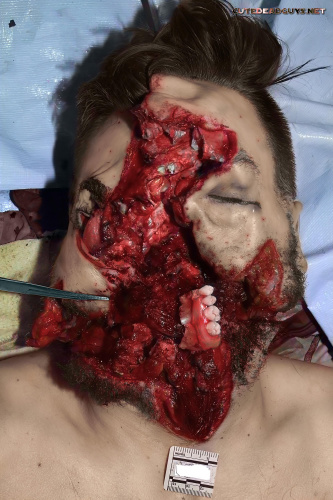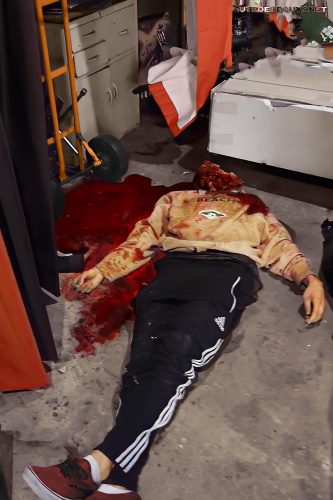

Detroit, MI. USA - A 21-year-old man was noted by family members to go into the garage behind their house, and moments later, there was an explosion. His mother found him unresponsive on the garage floor with massive trauma to his head. He had a medical history of depression with a previous suicide attempt by hanging 2 years prior to death. It was reported that the decedent argued with his mother regarding suspected drug activity and unauthorized withdrawals from her bank account before he went into the garage.
Police officers arrived at the scene under the premise that a male had shot himself in the head. At the location, family members suggested the decedent was playing with fireworks when the explosion occurred. Excluding the massive trauma to the head, no other injuries were apparent. A strong odor of gunpowder lingered in the air, and tissue and blood were broadcast over the entire garage. A lighter and a fuse were found on the floor near the body. An intact, homemade firecracker was found on a workbench near the body. While thorough searching failed to locate a firearm in the vicinity, additional homemade fireworks similar to the one found in the garage, commercially manufactured fireworks, and fuses were recovered from the decedent's bedroom inside the house. The homemade firecrackers were not examined by a pyrotechnic expert. They contained unknown quantities of flash powder, and based on the length and diameter of the cardboard tube used, the explosives resembled M-100 firecrackers.
Examination of the body revealed massive, nearly symmetric trauma to the head centered in the mouth. Multiple open defects to the head radiated from the mouth through the midmaxilla and nose and mid–frontal bone, from both corners of the mouth to both angles of the mandible, and through the mid mandible to the upper neck. Additional multiple open defects radiated from the open facial midline defect through the right orbit and through the left cheek. Superficial overextension skin tears extended across the right temple, right cheek, and lateral to the lateral canthus of the left eye.
Subsequent internal examination of the head revealed extensive comminuted fractures of bilateral facial bones, the anterior half of the calvarium, and the entire base of the skull. The brain and brainstem showed extensive maceration. Both frontal lobes of the brain, anterior cranial fossa, portions of orofacial soft tissue, and portions of the maxilla and mandible were absent. The tongue showed thermal burns on its anterior surface and multiple lacerations of its body. Radiographic examination of the body did not reveal any metallic projectiles within the head, and no pieces of cardboard or plastic material were recovered from the head. No other injuries and no diseases were present. Postmortem toxicology performed on peripheral blood samples revealed ethanol 36 mg/dL, cocaine 94 ng/mL, cocaethylene 79 ng/mL, and benzoylecgonine 1000 ng/mL.
Deaths involving explosives are not common in the United States and are usually from the mishandling of fireworks or are workplace accidents in mines, on roads, and at construction and demolition sites. Suicides from intraoral explosives are very rare, with only 7 reported cases in 6 articles published within the last 17 years. The victims are usually males with some knowledge and access to explosives. The injuries are localized to the head and consist of massive, largely symmetric destruction of the head. Given the massive, largely symmetric destruction of the head that centers on the mouth from the intraoral detonation of fireworks, these injuries can be easily mistaken for an intraoral shotgun wound. Important information is the absence of a firearm at the scene and the absence of any wadding or projectiles at the scene or within the head.
